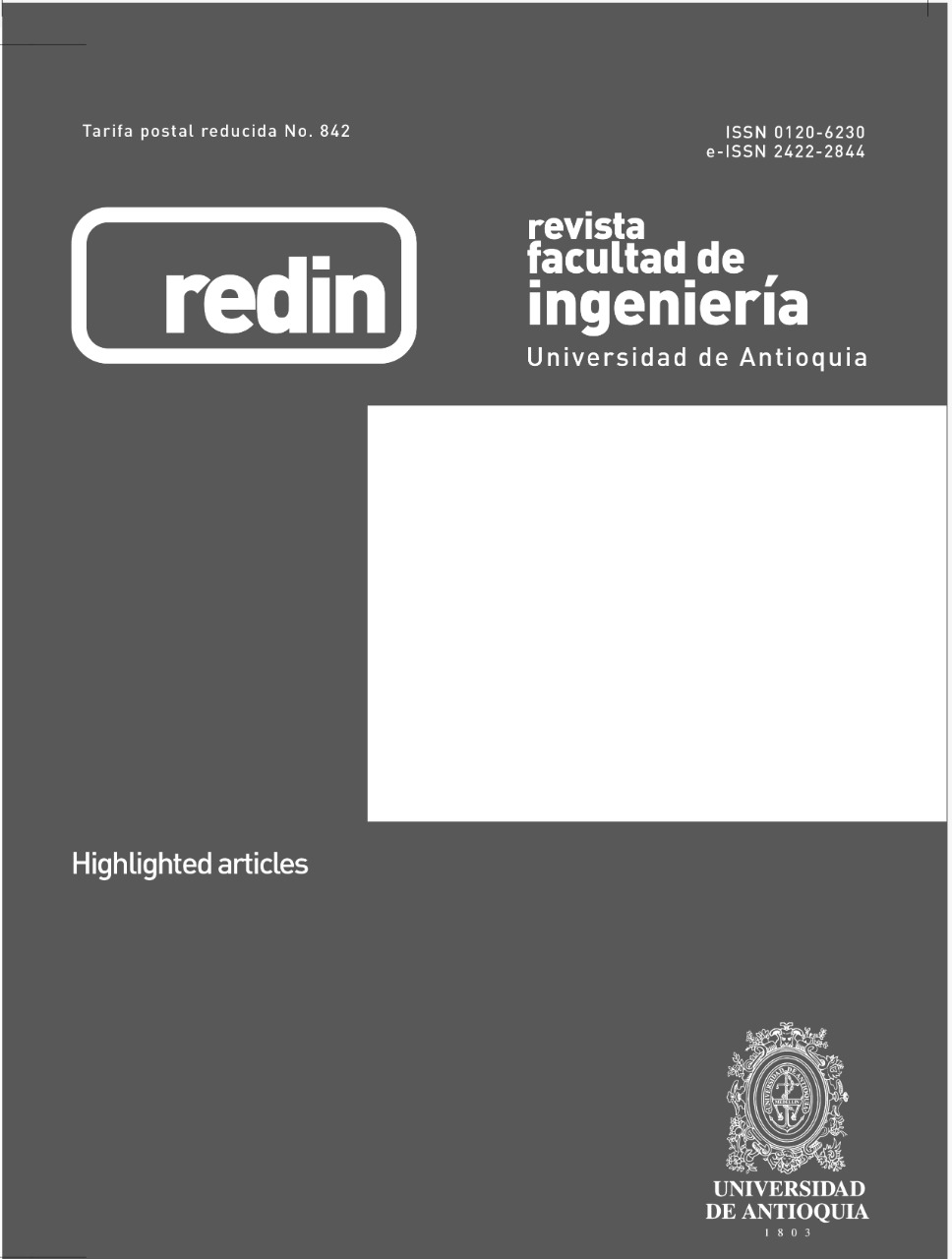Exergoeconomía en sistemas energéticos: Evaluación de los costos tecnológicos y económicos de un AHT
DOI:
https://doi.org/10.17533/udea.redin.20250370Palabras clave:
Exergonomía, análisis exergéticos, optimización de sistemas, transformador térmico por absorbción, eficiencia exergéticaResumen
La creciente preocupación por la conservación de energía y sus implicaciones en la rentabilidad de una empresa ha llevado a la creación de muchos modelos que combinan procesos energéticos con métodos de contabilidad de costos. En consecuencia, la industria ha centrado sus esfuerzos en identificar alternativas económicamente viables, tecnológicamente posibles y ambientalmente aceptables. Un enfoque para abordar las alternativas propuestas es realizar análisis exergonómicos de los sistemas energéticos implementados durante las operaciones para maximizar el uso de recursos. El presente trabajo de investigación evalúa el uso de un análisis exergoeconómico de un Transformador Térmico por Absorción (AHT, por sus siglas en inglés) para identificar áreas de mejora en la operación del sistema y, así, optimizar los parámetros esenciales para una mayor eficiencia tecnológica. Además, el estudio sugirió áreas de mejora en el generador (GE), economizador (EC) y absorbedor (AB) para futuros estudios, logrando eficiencias técnicas de hasta el 98% en ciertos componentes. Por lo tanto, considerar el costo como una medida de los recursos utilizados proporciona una visión profunda de los sistemas energéticos adoptados por la industria. Gracias a que la exergonomía considera los costos como una medida del consumo de recursos, este enfoque ofrece una visión integral de los sistemas energéticos adoptados por la industria. Estos resultados son relevantes para comprender el impacto potencial de integrar la eficiencia técnica, económica y ambiental en las prácticas de gestión energética dentro del sector industrial.
Descargas
Citas
C. Torres and A. Valero, “The exergy cost theory revisited,” Energies, vol 14, 1594, 2021.
G. Tsatsaronis and J. Pisa, “Exergoeconomic evaluation and optimization of energy systems. Application to the CGAM problem,” Energy, vol. 19, pp 287-32, 1994.
A. Valero et al., “Theory of Exergy Cost and Thermo-ecological Cost,” Thermodynamics for Sustainable Management of Natural Resources, W. Stanek (ed), Springer Cham, 2017, pp.167-202.
M. El-Sayed and B. Evans, “Thermoeconomics and the design of Heat Systems,” Journal of Engineering for Gas Turbings and Power, vol. 92, no.1, pp.27-35, 1970.
G. Tsatsaronis and M. Winhold, “Exergoeconomic analysis and evaluation of energy-conversion plants—I. A New General methodology,” Energy, vol. 10, no. 1, pp. 69-80, 1985
M. Von Spakovsky, “A Practical Generalized Analysis Approach to the Optimal Thermoeconomic Design and Improvement of Real-world Thermal Systems,” Ph.D dissertation, Georgia Institute of Technology, USA, 1986.
C. Frangopoulos, “Application of the thermoeconomic functional approach to the CGAM problem,” Energy, vol. 19, no. 3, pp.323-342, 1994.
A. Lazzaretto and G. Tsatsaronis, “SPECO: A systematic and general methodology for calculating efficiencies and costs in thermal systems,” Energy, vol. 31, no. 8-9, pp. 1257-1289, 2006.
R. Gaggioli and W. Wepfer, “Exergy economics: I. Cost accounting applications,” Energy, vol. 5, pp. 823-837, 1980.
G. Tsatsaronis, “Thermoeconomic analysis and optimization of energy systems,” Progress in energy and combustion science, vol. 19, pp.227.257, 1993.
E. Sciubba, “Beyond thermoeconomics? The concept of extended exergy accounting and its application to the analysis and design of thermal systems,” Exergy, an international journal, vol. 1, no. 2, pp. 68-84, 2001.
M. Lozano et al., “Theory of exergetic cost and thermoeconomic optimization,” in Energy systems and ecology, J. Szargut (ed), Cracov, Poland: OPAKOWR, 1993, pp. 339-350.
S. Seyyedi, “A New Method for the Residues Cost Allocation and Optimization of a Cogeneration System Using Evolutionary Programming,” Journal of Applied Dynamic Systems and Control, vol. 2, pp. 48-60, 2019.
L. de Araújo et al., “On the effects of thermodynamic assumptions and thermoeconomic approaches for optimization and cost allocation in a gas turbine cogeneration system,”, Journal of the Brazilian Society of Mechanical Sciences and Engineering, vol. 42, no. 323, 2020.
P. Rosseto de Faria et al., “The environment as a thermoeconomic diagram device for the systematic and automatic waste and environmental cost internalization in thermal systems,” Renewable and Sustainable Energy Reviews, vol. 171, 2023.
J. Pospisil and M. Balas, “Working Characteristics of Small-scale Absorption Unit with Two-Cylinder Design,” Wseas Transactions on Heat and Mass Transfer, Vol. 3, pp. 77-86, 2009.
I. Smith, “Bombas de calor por absorción,”. Seminario sobre conservación de energía y aplicaciones industriales y comerciales de las bombas de calor, Mexico, 1990.
Descargas
Publicado
Cómo citar
Número
Sección
Licencia
Derechos de autor 2025 Revista Facultad de Ingeniería Universidad de Antioquia

Esta obra está bajo una licencia internacional Creative Commons Atribución-NoComercial-CompartirIgual 4.0.
Los artículos disponibles en la Revista Facultad de Ingeniería, Universidad de Antioquia están bajo la licencia Creative Commons Attribution BY-NC-SA 4.0.
Eres libre de:
Compartir — copiar y redistribuir el material en cualquier medio o formato
Adaptar : remezclar, transformar y construir sobre el material.
Bajo los siguientes términos:
Reconocimiento : debe otorgar el crédito correspondiente , proporcionar un enlace a la licencia e indicar si se realizaron cambios . Puede hacerlo de cualquier manera razonable, pero no de ninguna manera que sugiera que el licenciante lo respalda a usted o su uso.
No comercial : no puede utilizar el material con fines comerciales .
Compartir igual : si remezcla, transforma o construye a partir del material, debe distribuir sus contribuciones bajo la misma licencia que el original.
El material publicado por la revista puede ser distribuido, copiado y exhibido por terceros si se dan los respectivos créditos a la revista, sin ningún costo. No se puede obtener ningún beneficio comercial y las obras derivadas tienen que estar bajo los mismos términos de licencia que el trabajo original.










 Twitter
Twitter